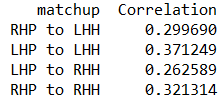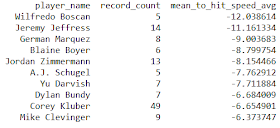A few weeks back, one year mild breakout Mark Trumbo officially re-upped with the Orioles for three years at 37.5 MM. It was about half of his initial total asking price and a year shorter. The Orioles effectively gave up a compensation round pick (Trumbo was a QO player likely to sign eventually), so the price tag was more around 43 MM overall. As the market has gone this past offseason, it was a good, but not great deal. Two of the closer comps price-wise to Trumbo would be Kendrys Morales (3/33) and Josh Reddick (4/52).
Age
|
xAVG
|
xOBP
|
xSLG
|
xrRC+
|
|
| Mark Trumbo | 31 | .251 | .307 | .491 | 110 |
| Kendrys Morales | 34 | .266 | .331 | .469 | 112 |
| Josh Reddick | 30 | .268 | .335 | .453 | 113 |
A few things jump out. One, as much press as the Blue Jays have gotten about Kendrys Morales, the only real knock against him is his age. His projected performance over his age 34 to 36 seasons does not vary far from where Trumbo and Reddick would be except that he likely has a far higher chance of collapse. Reddick's deal looked reasonable at the time, but looks rather solid right now. He can play both corners and puts up a value similar to Trumbo, but with more of an emphasis on drawing walks. If we accept that Trumbo's 3/37.5 contract was really a 3/43 deal with the draft pick loss, then Reddick at 4/52 looks like a far more desirable player. Anyway, Trumbo is the one the club signed. At a .337 wOBA, slightly above league average, it is not a very remarkable line, but one that would benefit most any batting order.
I do wonder, however, whether that line may not be reflecting the reality of Trumbo's playing time context. In other words, I question whether the projection model's failure to account for how well Trumbo hits as a designated hitter vs. how well he hits as a right fielder. Three years ago, MGL studied the impact of being a designated hitter had on hitting and found that there was a designated hitter penalty of .014 wOBA, which would be pretty significant for a player like Mark Trumbo.
Right now, it appears that he will face right handed pitching as a designated hitter and left handed pitching as an outfielder. It is somewhat generic to break it down this way, but let's say that break is about 400 PA at DH and 200 PA at RF. Let's also be a bit more generic and just assume all 400 of those DH PA are against RHP and all 200 of those PA in RF are against LHP. Try to let that go as this is simply a napkin scratch of an effort.
Now, it is accepted that batting is hand dependent on the pitcher. Trumbo is not much of a platoon hitter, but seems to have a little favorability against left handers (2016 being an outlier). But it is largely even (.335 wOBA vs LHP, .331 wOBA vs RHP career). Less known is that hitting appears to also be impacted by whether a player is in the field. Like handedness, not all players are affected by this, but some appear to be. For instance, Trumbo appears to be affected by whether or not he is out in the field with a 2015/2016 wOBA of .365 in the field and .310 at DH.
Player position appears that it will impact Trumbo far greater than the typical player assumed to be impacted in MGL's analysis. This might raise an eyebrow, but is not necessarily surprising. Individuals might vary greatly in how well they are able to stay focused on a task. In the greater world, people may need constant task processing to be able to quickly focus and assume a new task. On the other hand, people without constant tasks may lose concentration and have difficulty regaining it. We see some elements of this in attention deficit disorders and other focus issues. It is why some doctors suggest to patients with poor daily focus to keep crosswords or other word puzzles around to keep the mind engaged between tasks. That said, this is not exactly a firm, consensus opinion.
So, let's apply handedness and positional effects to Trumbo's line. Applying handedness to the projections, we get:
RHP 251/310/483, .232 ISO and .335 wOBA
LHP 251/302/506, .255 ISO and .340 wOBA
Next, we apply position:
DH and RHP 216/272/419, .192 ISO and .281 wOBA
RF and LHP 286/339/570, .296 ISO and .396 wOBA
Overall 239/294/470, .227 ISO and .319 wOBA
At that point, things look pretty terrible. Perhaps, the DH specific numbers are an anomaly and will even up over time. That said those numbers have about 400 PA, which has some meaning attached to it. It probably won't happen, but it might be best for the team to consider whether the best alignment is with Trumbo at first base and Chris Davis in the designated hitter role. During his time with the Orioles, Davis really only served as a designated hitter during the 2015 season and his production dropped 13% in comparison to when he was playing first base. That might be a real effect or it might be simply that Davis was the DH when he needed a blow.
Perhaps a cause for optimism was a study published by the Hardball Times in 2015. It found that it takes about 50 PA for a pinch hitter to lose their pinch hitting penalty, which is similar to a designated hitter penalty. Maybe being a designated hitter requires adjustment just like being able to perform at a new position. So how did Trumbo do as a designated hitter last year as the season progressed in thirds?
| Thirds |
1st
|
2nd
|
3rd
|
| RF | .899 | .836 | .924 |
| DH | .908 | .731 | .712 |
| Penalty | .009 | -.105 | -.212 |
Well, that is interesting. And, well, potentially alarming. It appears that perhaps the Orioles should look to get Trumbo into the field as much as possible.






